How To Set Up A Big Agnes Copper Spur Tent
Large Agnes Copper Spur HV UL2
Price: $450
Packaged weight: iii lbs. 1 oz. (2P)
Flooring area: 29 sq. ft.
Capacities: 1P, 2P, 3P, 4P
What nosotros like: Standout combination of livability, weight, and ease of utilise.
What we don't: Thin materials and high price.
See the Large Agnes Copper Spur HV UL2
First introduced in 2008, the Copper Spur series past Large Agnes has been a consistent frontrunner in the ultralight tent category. Lightly updated concluding year, we tested the latest two-person model on a series of backpacking trips in Patagonia. All told, the high-quality build, competitive weight, two-door-and-foyer layout, and open interior go far one of the virtually complete backpacking tents on the market. Below we intermission downwards our experiences with the legendary Copper Spur. To run into how it stacks up to the competition, run into our article on the best backpacking tents.
Tabular array of Contents
- Weight and Packed Size
- Livability and Interior Space
- Durability
- Weather condition Protection
- Ventilation
- Vestibules and Storage
- Fix and Take Down
- What We Like/What We Don't
- Comparison Table
- The Competition
Performance
Weight and Packed Size
On our scale, the Big Agnes Copper Spur HV UL2 has a full packaged weight of 3 pounds 1 ounce (just nether its iii lbs. ii oz. listed weight). While technically 1 ounce heavier than the prior version, it'due south still in pretty elite company: amidst lightweight freestanding models, the popular Nemo Dagger 2P and MSR Hubba Hubba NX (both 3 lbs. fourteen oz.) are quite a bit heavier. The tent does fall short of ultralight designs similar Nemo's Hornet (2 lbs. 6 oz.) and Big Agnes' own Wing Creek HV UL2 (two lbs. 4 oz.) and Tiger Wall UL2 (two lbs. 8 oz.), but these tents compromise big fourth dimension in terms of interior space and just have semi-freestanding builds that aren't every bit piece of cake or quick to pitch. For its combination of space, convenience, and features, the Copper Spur's weight is fantastic.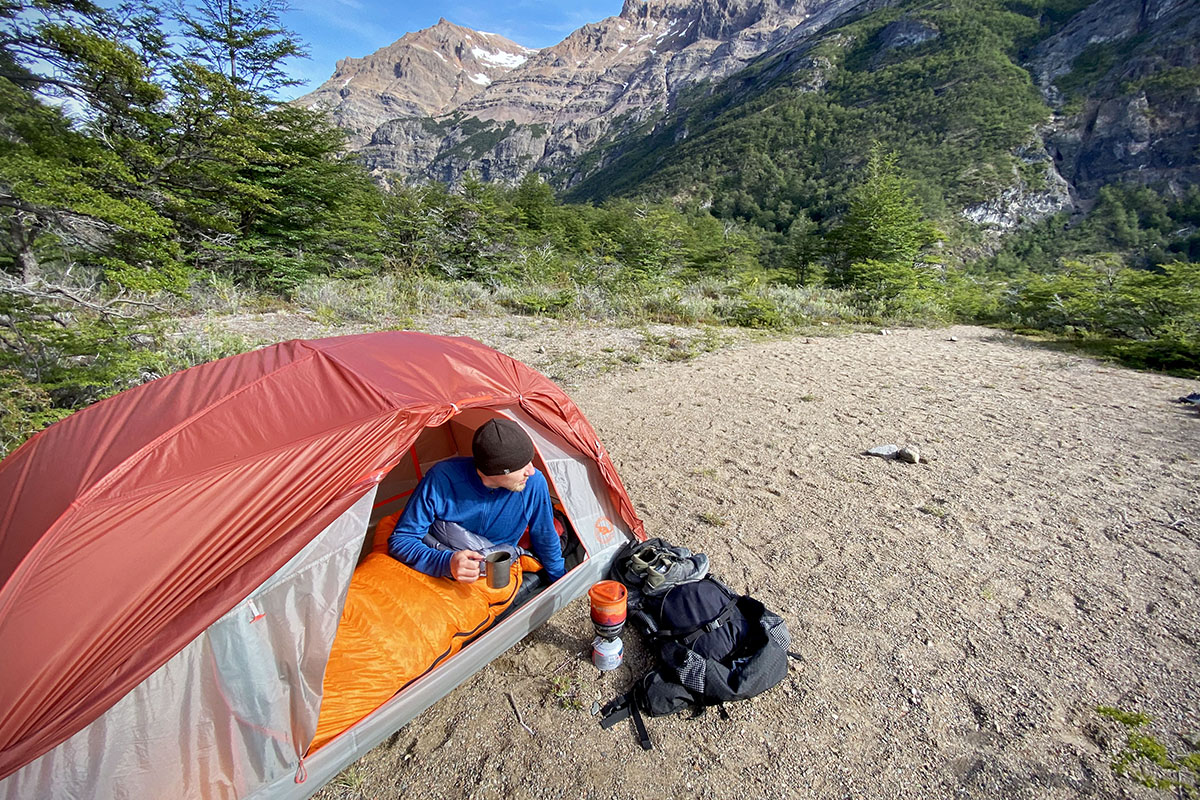
Equally far every bit packability goes, the tent stuffs down to 6 x xix.5 inches, which amounts to a pocket-sized increase in diameter compared to the prior generation (length remains the same). Importantly, information technology nevertheless fits nicely into its stuff sack, and we've had no problems squeezing it into our backpacking packs. And the Copper Spur is however enough competitive in the market, undercutting the REI Co-op Quarter Dome SL two (7 10 20 in.) and Nemo Dagger 2P (six.5 x nineteen.5 in.), while coming upwardly a little brusque of the Tiger Wall UL2 (v.5 10 18 in.). Just if space is a concern, you tin always split up the pole bag from the residue of the tent, as its pre-aptitude sections and hubbed organisation are responsible for a lot of the majority.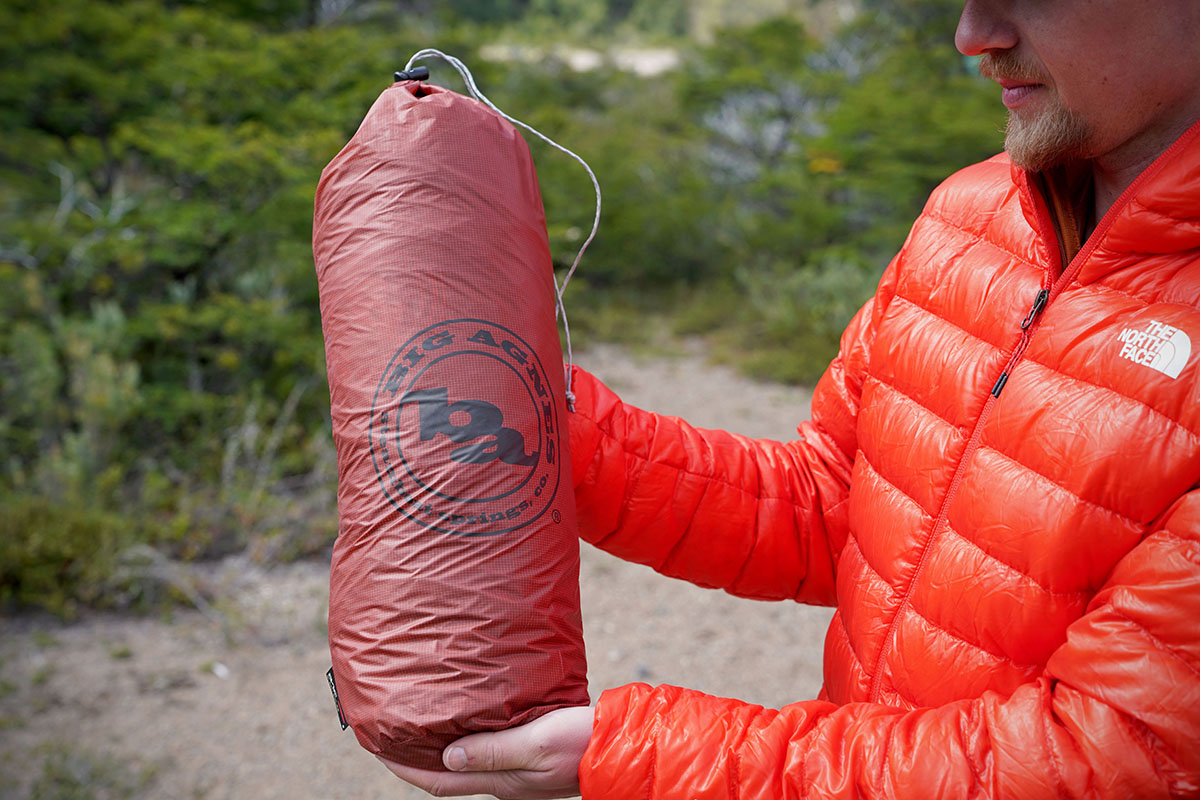
Livability and Interior Infinite
Now in its second generation, the Copper Spur'southward HV (for "high-volume") pole construction offers standout livability. The fully freestanding construction keeps the tent body taut even when camping on difficult surfaces similar rock, and Big Agnes further boosted interior space with pre-aptitude pole sections at each corner. Getting into the tent, the open feeling is immediately credible: the interior is most rectangular cheers to the nigh-vertical side walls and large, flat roof. Meridian height is reasonably tall at 40 inches, and the crisscrossing pole construction makes it easy for two people to sit upward side by side. It'south truthful that the tent height drops towards the foot stop, but even that space is adequately generous. All told, the pole system may increase weight a little, but if you'll exist consistently camping with a partner, nosotros think the tradeoff in roominess is well worth it.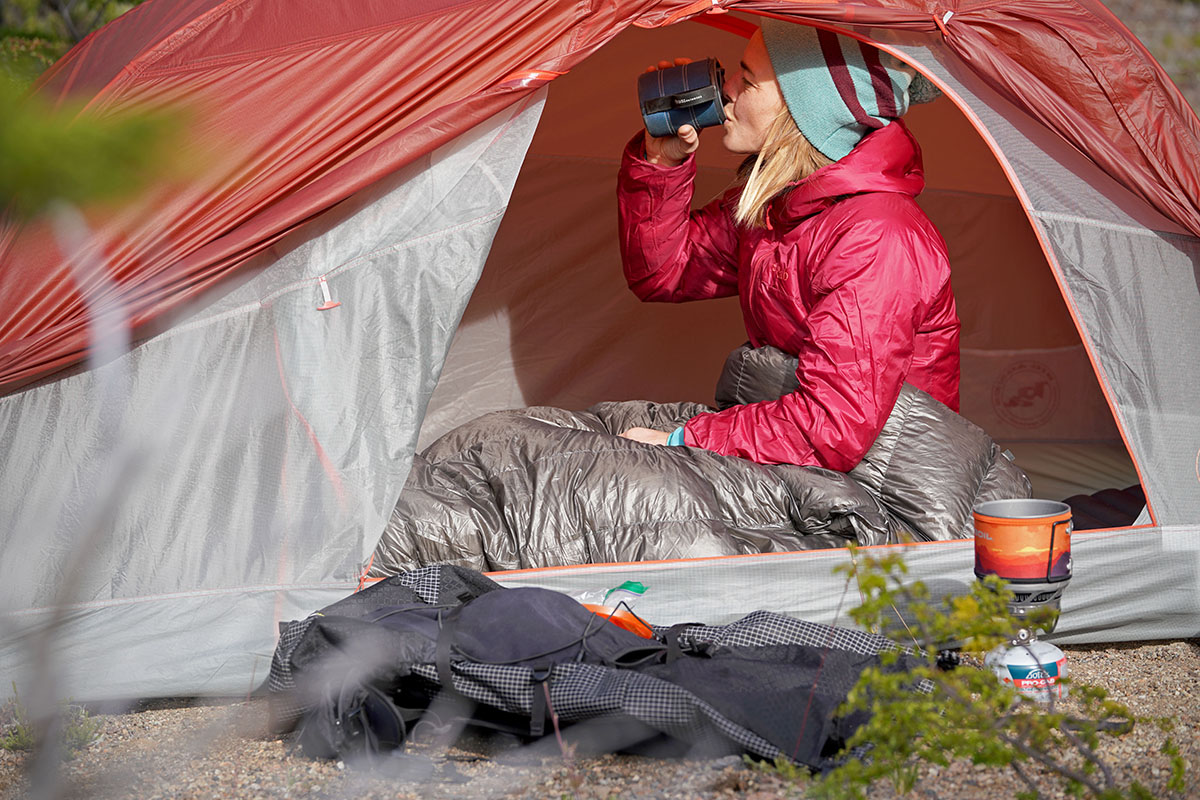
The pole blueprint accomplishes its goal of maximizing interior book, only information technology'south important to note that the tent's footprint still is relatively small-scale. The Copper Spur measures 52 inches wide at the head end of the tent and a tapered 42 inches at the feet, and its actual widths are a couple inches less for each (this is common amid tents). As a event, you tin only slumber with your head at one end. In addition, if y'all are sharing the infinite with a partner, it'due south best to use a mummy-shaped sleeping pad to maximize room at the foot terminate. With this layout, it's possible to clasp one wide 25-inch pad alongside a regular 20-inch pad without whatsoever overlap (two wide pads could exist tricky to pull off).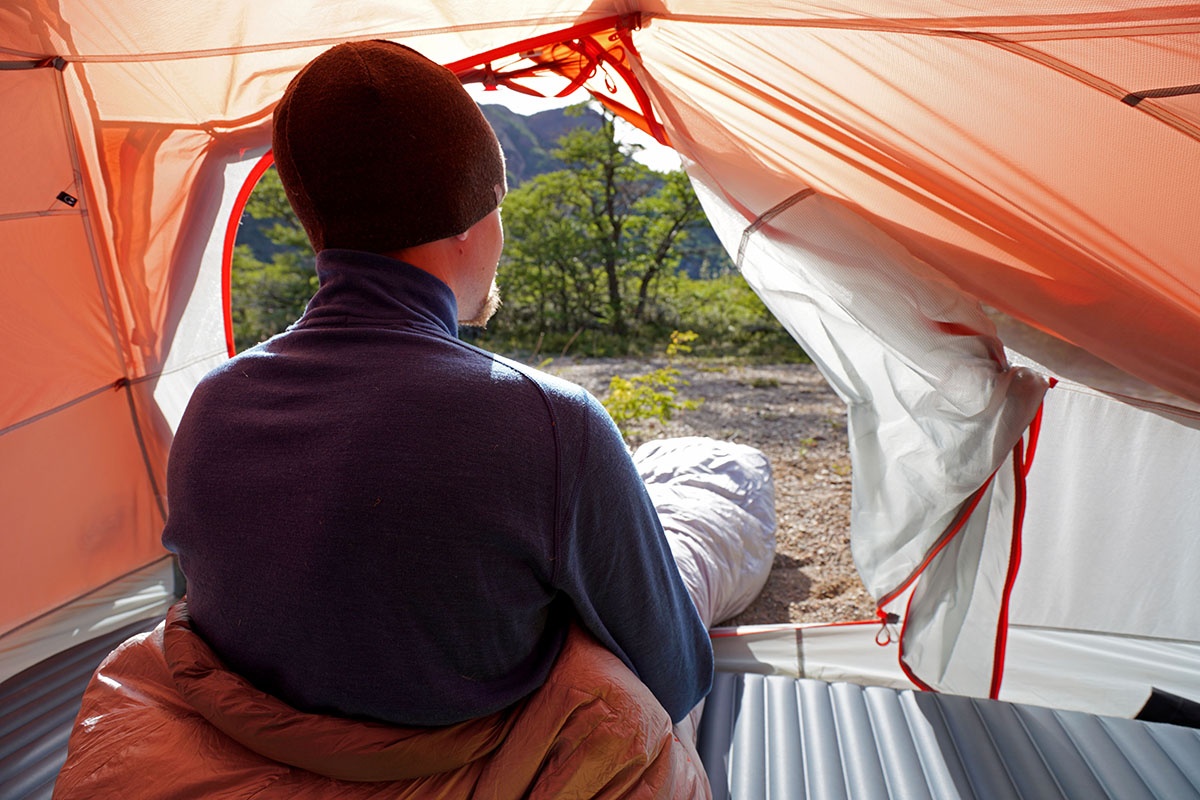
Durability
Cutting weight from a tent usually involves utilizing sparse and delicate materials, and the Copper Spur HV UL2 is no exception. Denier (D) commonly is used to measure fabric thickness (it actually is the material yarn's weight), and this Big Agnes tent has lightweight and depression-denier fabrics throughout. The floor, rainfly, and solid cloth portion of the tent body use a mixed 15D x 20D nylon, and the mesh on the tent body is also quite thin at 15D. For comparison, the MSR Hubba Hubba NX has a 30D floor for a modest increase in durability (and weight) in the area nearly probable to go a tear. There are even lower-denier fabrics on the market, including Nemo's Hornet and REI Co-op's Flash Air tents, which have 15D nylon floors. We've found that these tents button our condolement level in terms of cloth thickness, but actress care is advisable for all modern lightweight tents.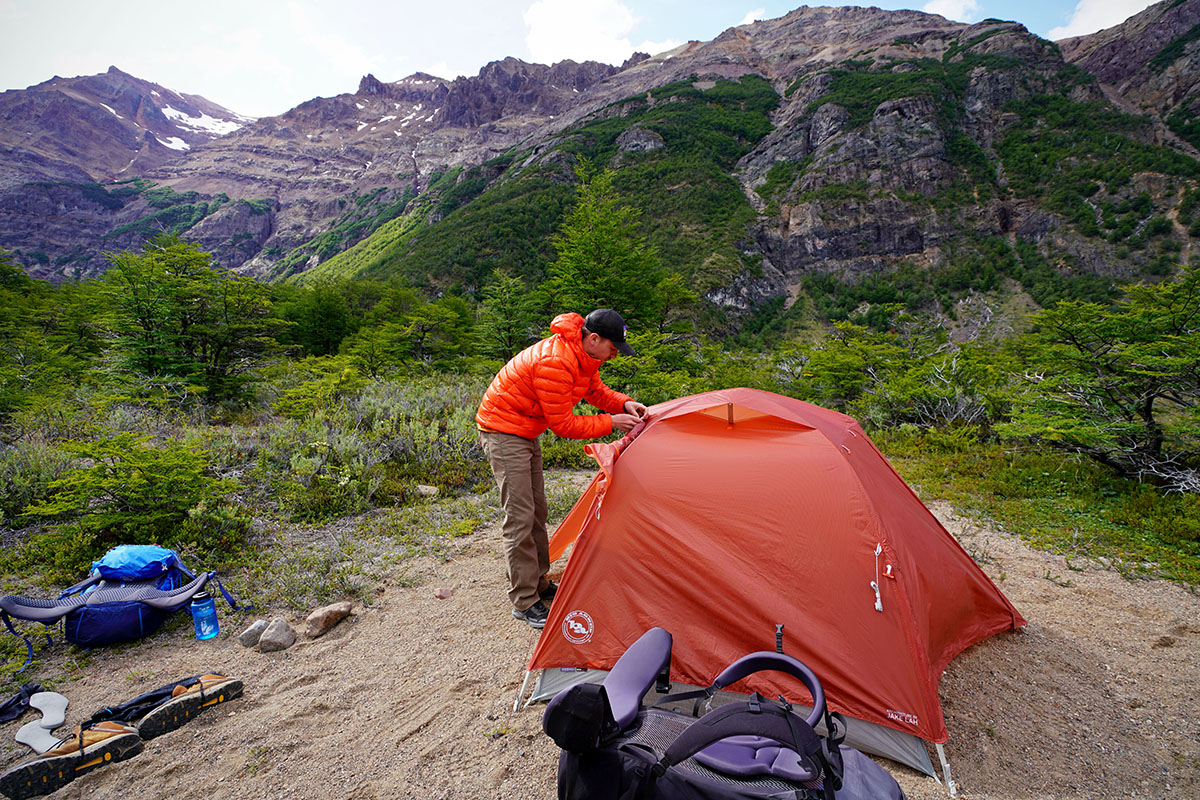
Information technology's of import to note that the denier measurement does not take into account various cloth technologies. Big Agnes uses a proprietary nylon in a unique double-ripstop weave on the floor and fly, with the more substantial 20D sections offering increased tear force. In use, the fabrics are light and thin simply have a quality experience and are certainly nada out of the ordinary in this category. In addition, it'due south worth noting that the zippers on the tent body and rainfly experience noticeably more substantial and trustworthy compared with the prior model. And most chiefly, everything from the fabrics to the DAC poles and stakes are holding up very well subsequently two backpacking trips.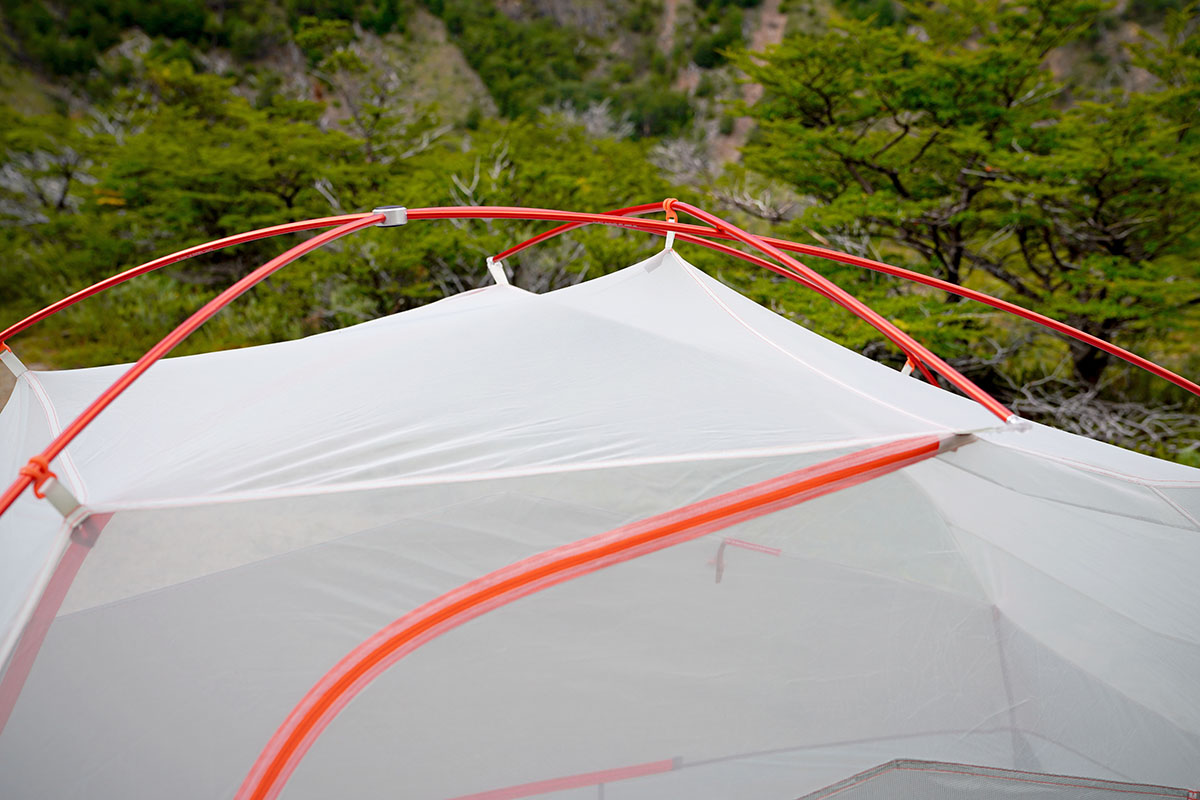
Atmospheric condition Protection
On our trip in Patagonia, our Copper Spur HV UL2 held potent in conditions ranging from moderate air current and blowing dust to a full dark of rainfall. The taut, fully freestanding structure was very sturdy in gusty weather, and the full-coverage rainfly did a squeamish job shedding persistent pelting. Plus, the tent does a nice job blocking splashing water besides equally bravado dust thanks to a fly that sits low to the ground and a tall bathtub floor. Big Agnes likewise includes guyout points at each corner and guylines to further increase forcefulness, although you'll need to bring along extra stakes to apply them. Like well-nigh iii-flavor tents, the Copper Spur is not built for fending off heavy snow, and it'southward best to pick protected campsites, merely the tent has proven to be quite capable in about inclement weather.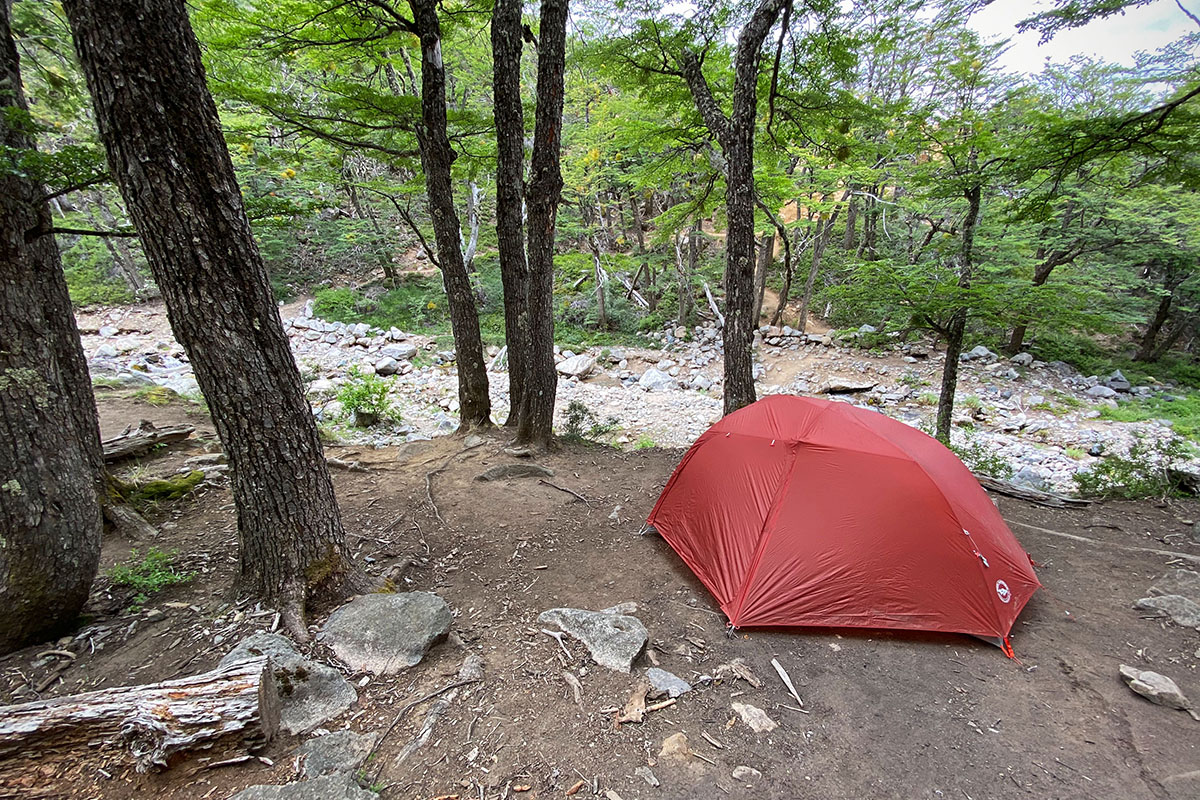
Ventilation
Liberal apply of mesh on the tent torso and a large, deployable vent at the top of the rainfly provide skilful all-around ventilation. And different some ultralight tents that utilize a single-wall construction, the double-wall build on the Copper Spur does a swell job keeping air moving and reduces the chance of condensation buildup. Importantly, there is good spacing between the rainfly and tent trunk to encourage airflow, including stakeout points on the rainfly at the head and human foot ends. And if conditions are right, you can pale out the vestibules in an awning-like set-up to actually boost ventilation (more on this below). In more extreme temperatures—we peaked in the mid 70s on our Patagonia trip—a 2nd roof vent might be helpful for releasing hot air, but we were reasonably comfortable even with the sunday hit the tent in the late afternoon.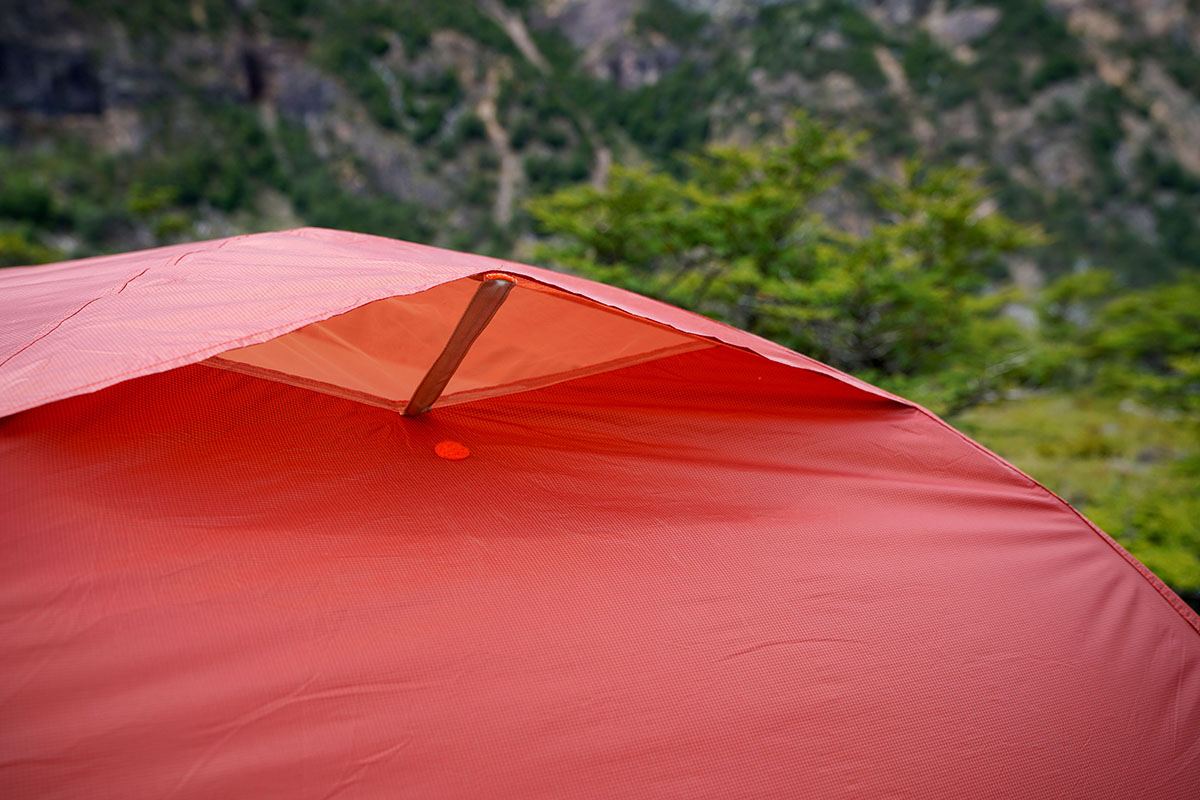
Vestibules and Storage
We really value the convenience that comes with a two-door-and-vestibule design. Existence able to store gear on both sides, and not having to worry about crawling over your tentmate in the night, are well worth the actress ounces, in our opinion. The Copper Spur'due south ii vestibules measure 9 foursquare feet each, which is most boilerplate for a lightweight tent, and they are big enough to store a backpacking pack and shoes without tripping you lot on your way inside. Interior storage is excellent, with a long pocket built into the tent'due south roof on the head end that easily stretches to arrange something as wide as a headlamp, and there are ii small pockets at caput height located just in front end of the doors. Additionally, Big Agnes added a huge pocket on the foot end that stretches the full width of the tent. The open up, hanging mesh pattern has proven to be very handy for stowing large items and drying out wet gear during the day.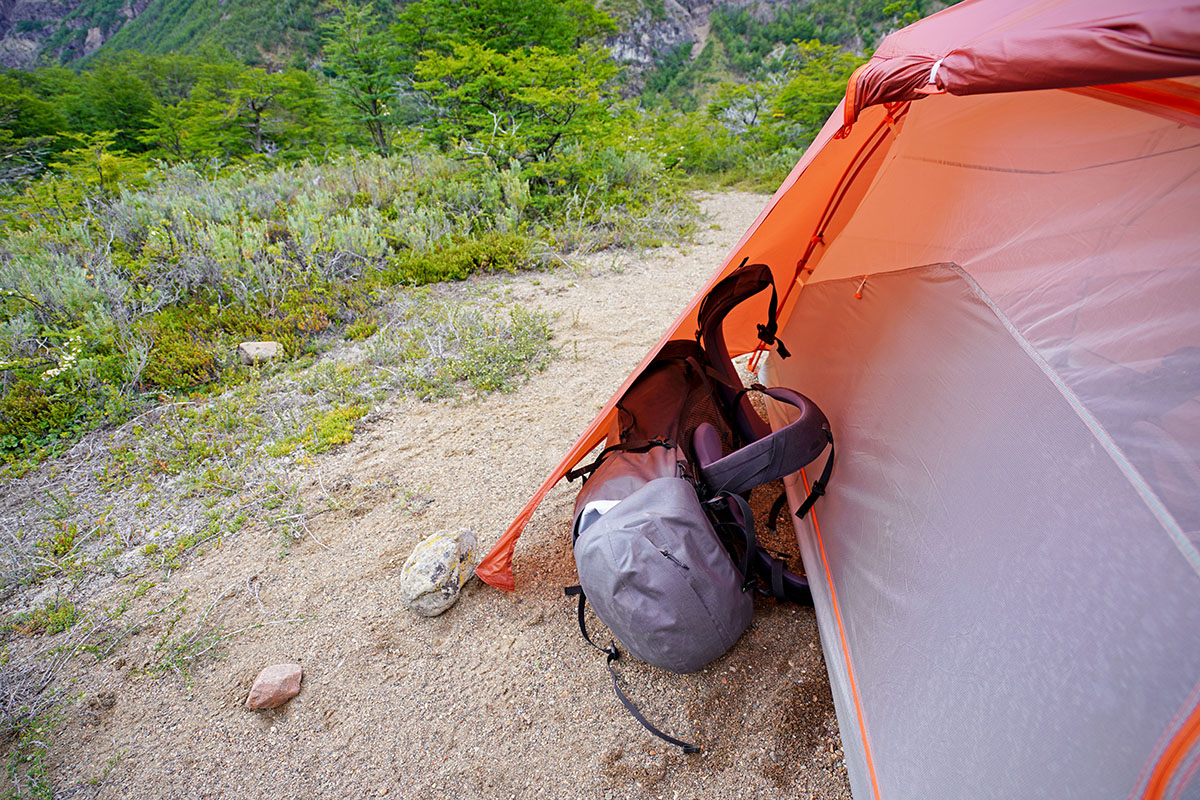
Along with the changes to the pocket layout, some other notable upgrade on the latest Copper Spur was a new, adaptable vestibule. Big Agnes added a 2nd zipper onto each vestibule, which allows y'all to prop open up the doors for an awning-similar gear up-up. This requires trekking poles and using the included guylines (iv sets come up with the tent), but information technology's a nice feature that increases airflow while retaining plenty of dominicus protection. We suspect a good number of backpackers won't utilise the awning, only the good news is that the second attachment on the vestibule likewise makes it easier to quickly access the interior door.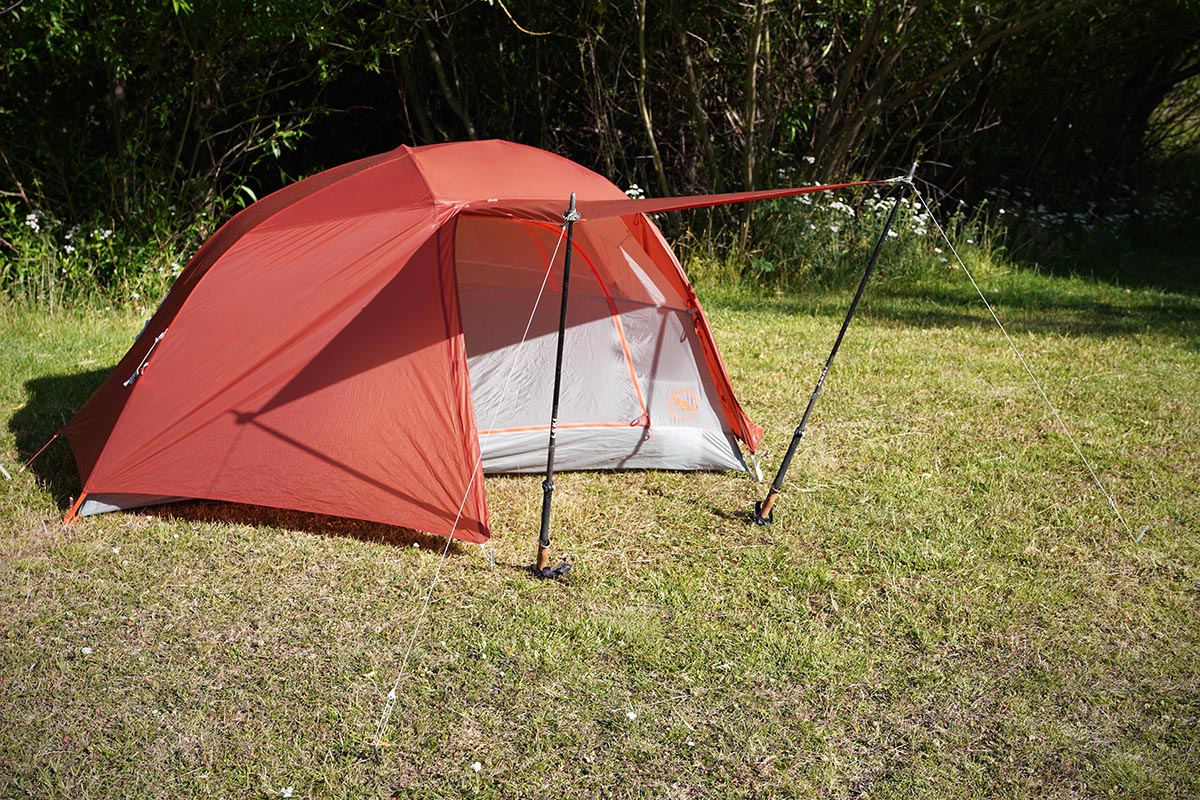
Set upwardly and Take Down
Nosotros had a range of non-freestanding and ultralight backpacking tents on our trip, and their finicky fix-up processes fabricated us really appreciate the quick and logical design of the Copper Spur. The freestanding build goes upwards easily by staking out the corners, inserting the poles into the color-coordinated grommets on either stop (the non-symmetrical shape means there is only ane way to set it up), and clipping in. The eye hub creates the X-shaped construction, and a separate small ridge pole connects at the top of each door. The fly goes on over the top, buckles conveniently at each corner, and can pulled taut with Velcro attachments for the poles and guylines on all sides. Unsurprisingly, tear-down is just equally quick and easy. The whole procedure didn't accept more than than a few minutes even on the commencement effort, and we too found it relatively simple to pitch in the wind.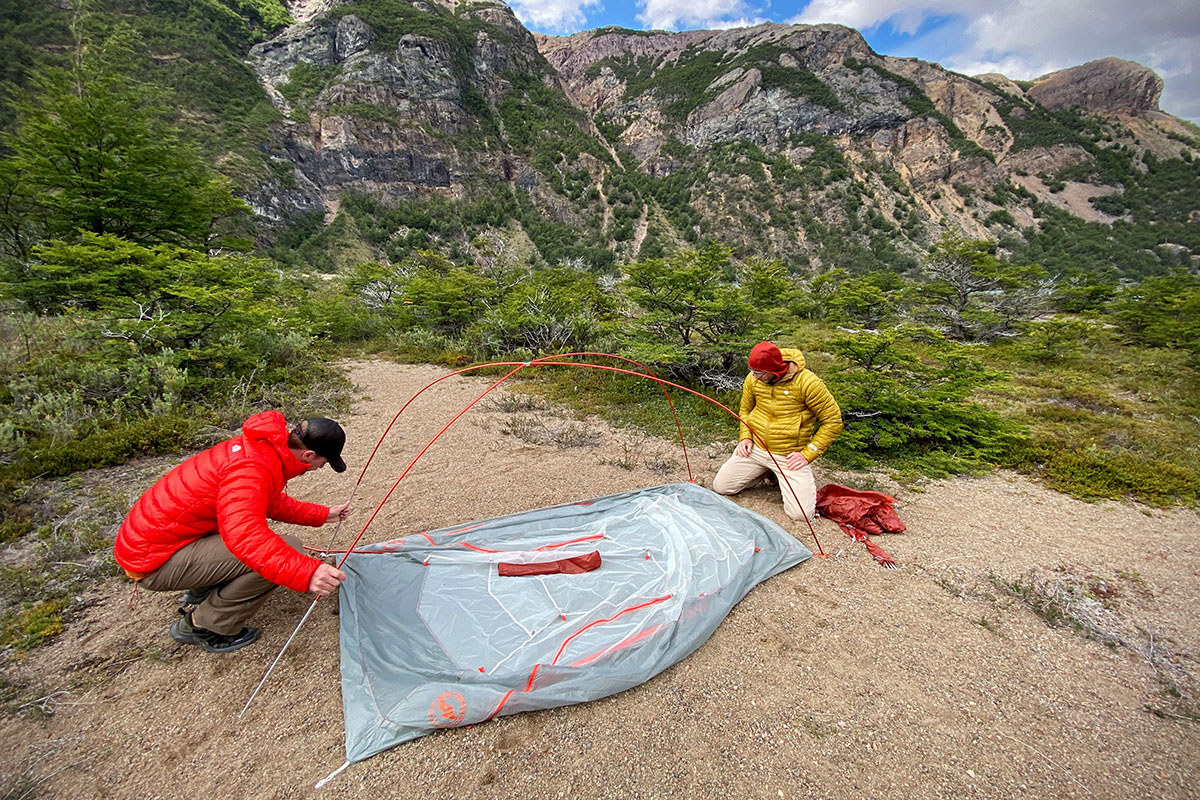
Other Capacities of the Big Agnes Copper Spur HV UL
We put the Copper Spur HV UL2 through its paces for this review, and Big Agnes also makes the same tent in one-, iii-, and four-person versions. The pattern remains largely the same beyond all three capacities, although the tents vary in weight, price, interior and vestibule space, and peak height. Every bit we touched on above, the 2P we tested struggled to fit two broad-width sleeping pads, then sizing up to the three-person version (three lbs. fourteen oz. and $500) makes a lot of sense for those with a dog or who simply desire added room to move effectually. Within the larger "HV" line, which all share the hubbed pole system, Large Agnes offers MTNGlo versions (1-3P) with built-in string lights, every bit well every bit bikepack-specific models (1-2P) with shortened pole segments and other specialized features for easy on-the-go storage. There also are lighter Platinum (2-3P) and beefed-up, mountain-ready Trek (two-3P) variations, both of which are more targeted options than the version tested here.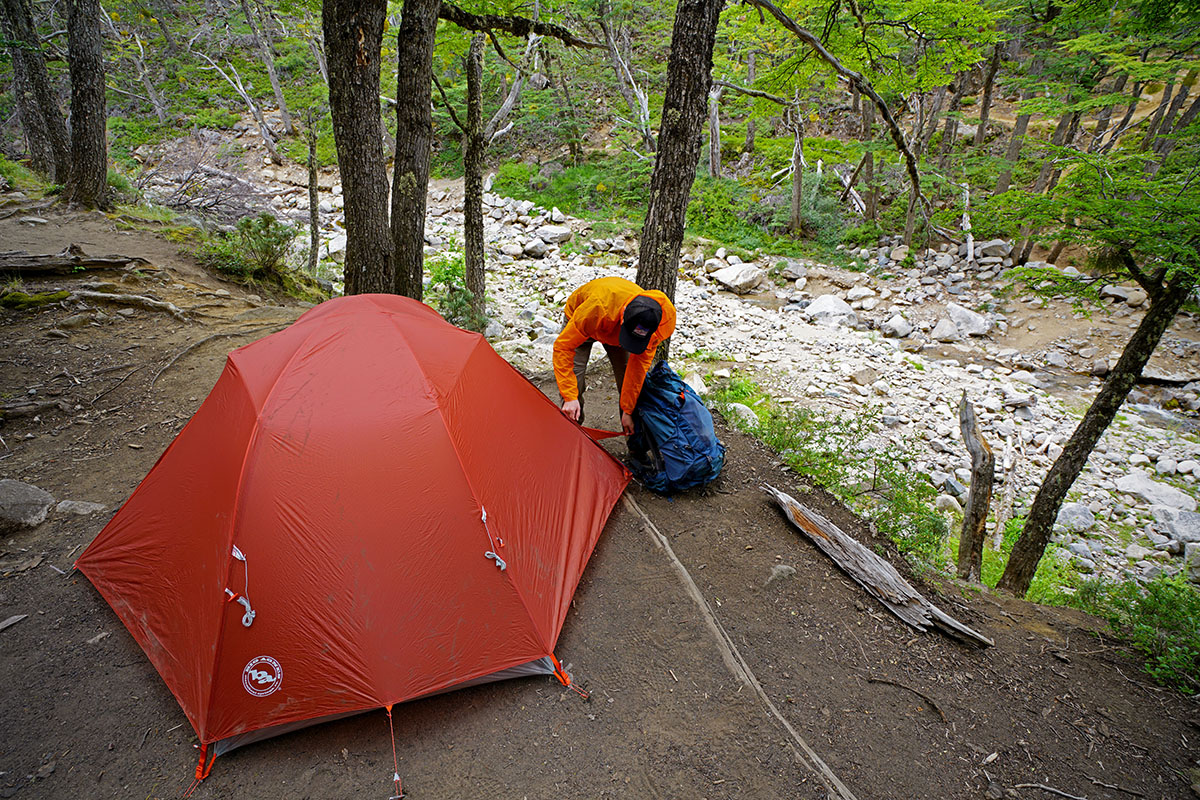
What We Like
- Iv-way, high-volume pole design does a great chore opening up the interior.
- Highly practical despite the 3-pound-2-ounce weight: two doors and vestibules, practiced ventilation, and a full-coverage rainfly.
- Lots of features, including large interior pockets and adaptable vestibules that tin can be set up up as awnings.
- Quality construction and an easy ready-upward and take-down.
What Nosotros Don't
- Even with the advanced fabrics, the 15D 10 20D nylon (on the flooring in particular) requires extra care.
- Tapered structure ways you can only sleep in one direction, and it will be hard to fit two wide sleeping pads.
- Fairly expensive at $450 for the UL2 model.
Comparing Table
| Tent | Price | Weight | Flooring | Surface area | Superlative | Door(southward) | Capacities |
|---|---|---|---|---|---|---|---|
| Big Agnes Copper Spur HV UL2 | $450 | 3 lbs. 2 oz. | 15x20D | 29 sq. ft. | 40 in. | 2 | 1P, 2P, 3P, 4P |
| Big Agnes Fly Creek HV UL2 | $370 | 2 lbs. iv oz. | 20D | 28 sq. ft. | 42 in. | 1 | 1P, 2P |
| Nemo Hornet 2P | $370 | two lbs. 6 oz. | 15D | 27.5 sq. ft. | 39 in. | 2 | 1P, 2P |
| Big Agnes Tiger Wall UL2 | $400 | 2 lbs. viii oz. | 15D | 28 sq. ft. | 39 in. | 2 | 1P, 2P, 3P |
| REI Quarter Dome SL 2 | $349 | 2 lbs. 14 oz. | 15D | 28.7 sq. ft. | 38 in. | 2 | 1P, 2P |
| Nemo Dagger 2P | $430 | 3 lbs. 14 oz. | 30D | 31.3 sq. ft. | 42 in. | two | 2P, 3P |
| MSR Hubba Hubba NX | $450 | iii lbs. 14 oz. | 30D | 29 sq. ft. | 39 in. | 2 | 1P, 2P, 3P, 4P |
The Competition
As with the first 3 generations of the Copper Spur, the latest model is a standout in the backpacking tent market: it bridges the gap nicely between lightweight and convenient designs that weekend backpackers love and focused ultralight models for thru-hikers and minimalists. We strongly prefer the Copper Spur HV to Big Agnes' own Fly Creek HV UL2, which we feel is too compromised with its unmarried door/lobby and non-freestanding pattern. That said, the Fly Creek gets the articulate edge in weight at 2 pounds 4 ounces, and information technology'southward likewise the cheaper selection at $370. But given the added convenience and overall livability, we think the Copper Spur is the more well-rounded backpacking pattern.
Nemo'southward Hornet 2P is another ultralight option that does include two doors and vestibules. However, as with the Fly Creek HV, the interior is simply likewise cramped for most backpackers (the 2-person model works best for solo travelers). That said, Nemo did requite the tent a bump in interior space recently with 2 "FlyBar" pole clips, which make information technology a flake easier for two campers to sit upward side-by-side inside the tent. And once more, the Nemo beats the Copper Spur in both weight and toll at two pounds half-dozen ounces and $370, respectively. But in the end, we still call back the bump in interior space and livability are worth the weight penalty yous get with the Big Agnes.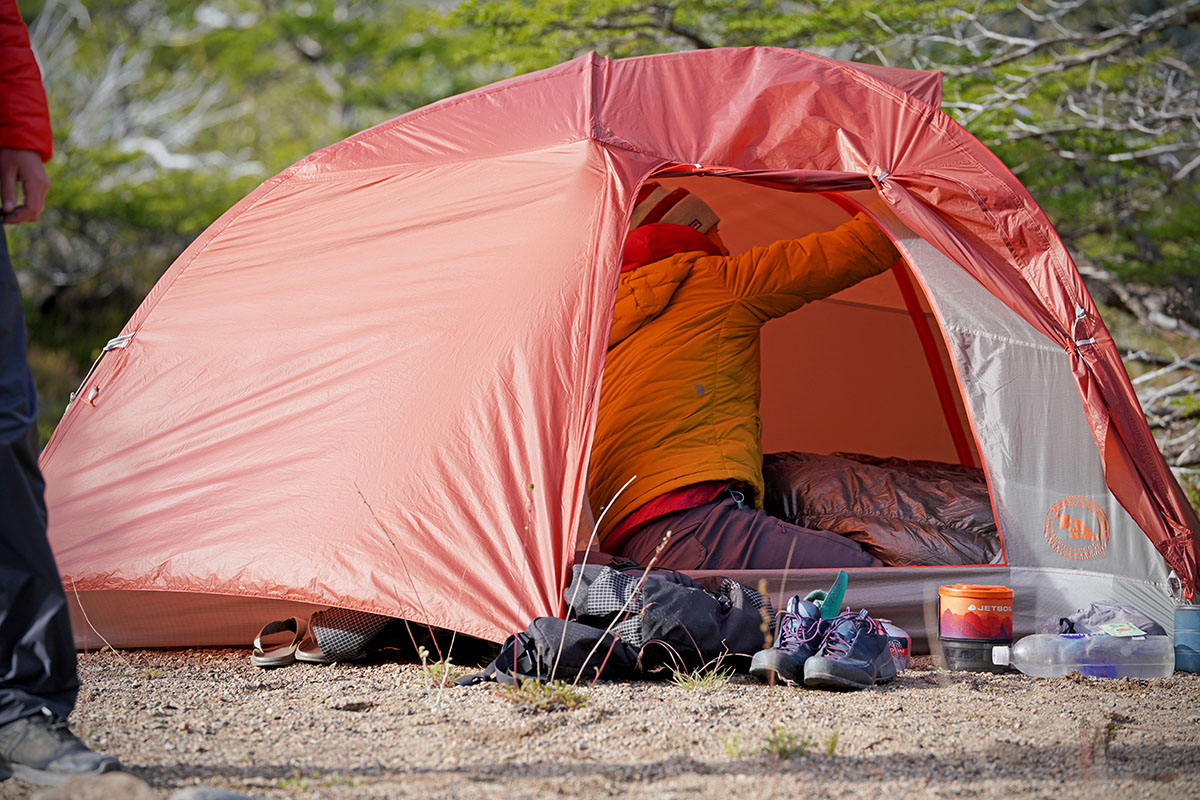
Some other ultralight tent from Big Agnes is the Tiger Wall UL2, which blends blueprint elements from the Copper Spur and Fly Creek lines. The Tiger Wall has ii doors and vestibules and a center ridge pole similar the Copper Spur, but its semi-freestanding layout trims weight even further. Compared with the Copper Spur, the Tiger Wall is lighter past 10 ounces and comes in $l cheaper (for more information, see our in-depth Tiger Wall review), but the Copper Spur is the one nosotros prefer in nigh cases. Its freestanding structure is easier to gear up on just about any surface, the materials are more durable, and its pole design does a better job opening up the interior. The Tiger Wall has a lot of appeal for solo trekkers and thru-hikers, but we think the Copper Spur is the better accommodating option, and particularly for more casual backpackers.
Outside of Big Agnes' lineup, REI's Quarter Dome SL 2 is a strong upkeep culling to the Copper Spur, which costs virtually $100 less while undercutting the Big Agnes in weight by 4 ounces. All the same, we also tested the REI on our trip to Patagonia and plant it to be noticeably tighter inside, and its mesh-heavy construction is more prone to letting in bravado grit. In addition, the semi-freestanding construction makes information technology more hard to fix on rocky surfaces, although it's still an all-around user-friendly pattern. In the end, the Copper Spur's ameliorate livability makes it worth the added cost and weight for us, only both are well-balanced, lightweight backpacking tents.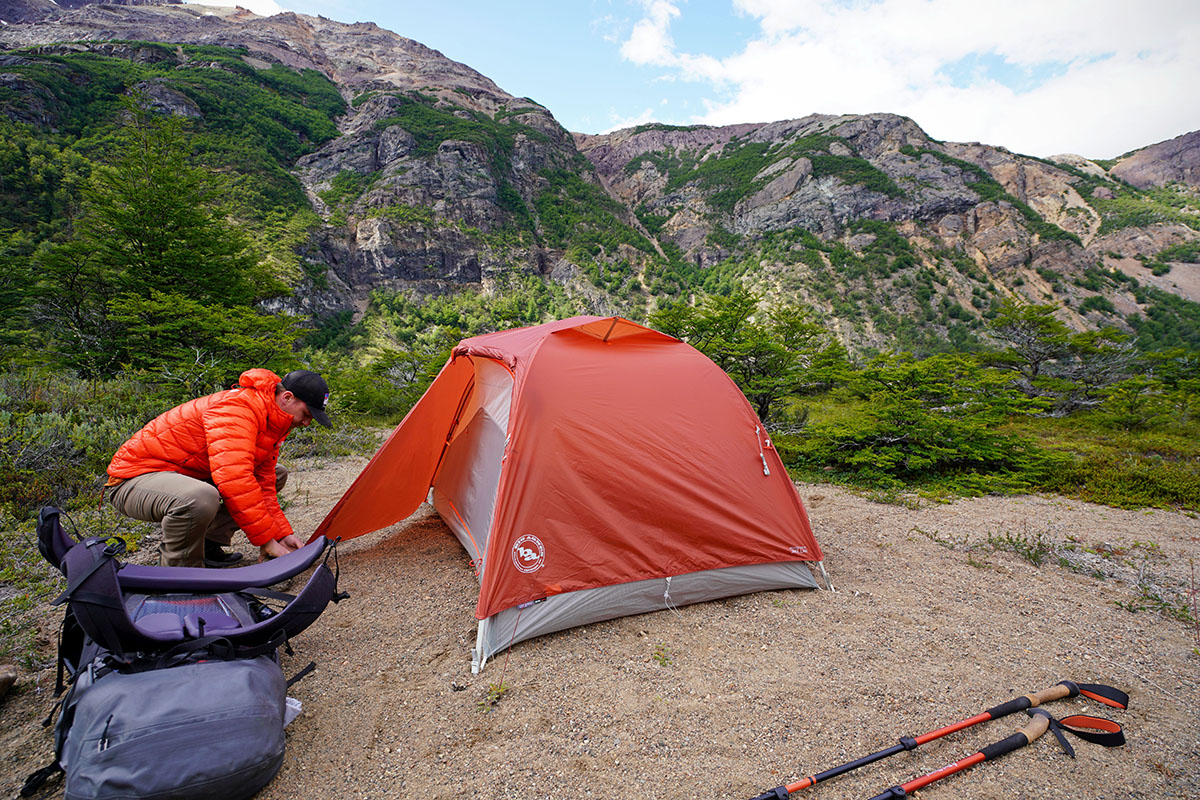
If yous're willing to add together a fleck of weight to your pack, the Nemo Dagger 2P and MSR Hubba Hubba NX and are 2 excellent backpacking models. Nosotros love the more durable fabrics that y'all go with the Nemo and MSR, and their symmetrical shapes mean you lot tin can sleep head-to-toe for more room to movement around. Every bit mentioned in a higher place, however, the Copper Spur beats them rather hands in weight (past 12 oz. for both). And possibly most impressively, the Copper Spur pulls this off while retaining a double-wall, freestanding structure and two-door-and-vestibule blueprint. All told, all iii are solid options and top choices in our backpacking tent round-up, and a final decision will come down to how you prioritize weight and space.
How To Set Up A Big Agnes Copper Spur Tent,
Source: https://www.switchbacktravel.com/reviews/big-agnes-copper-spur-hv-ul2
Posted by: carlsonwict1992.blogspot.com

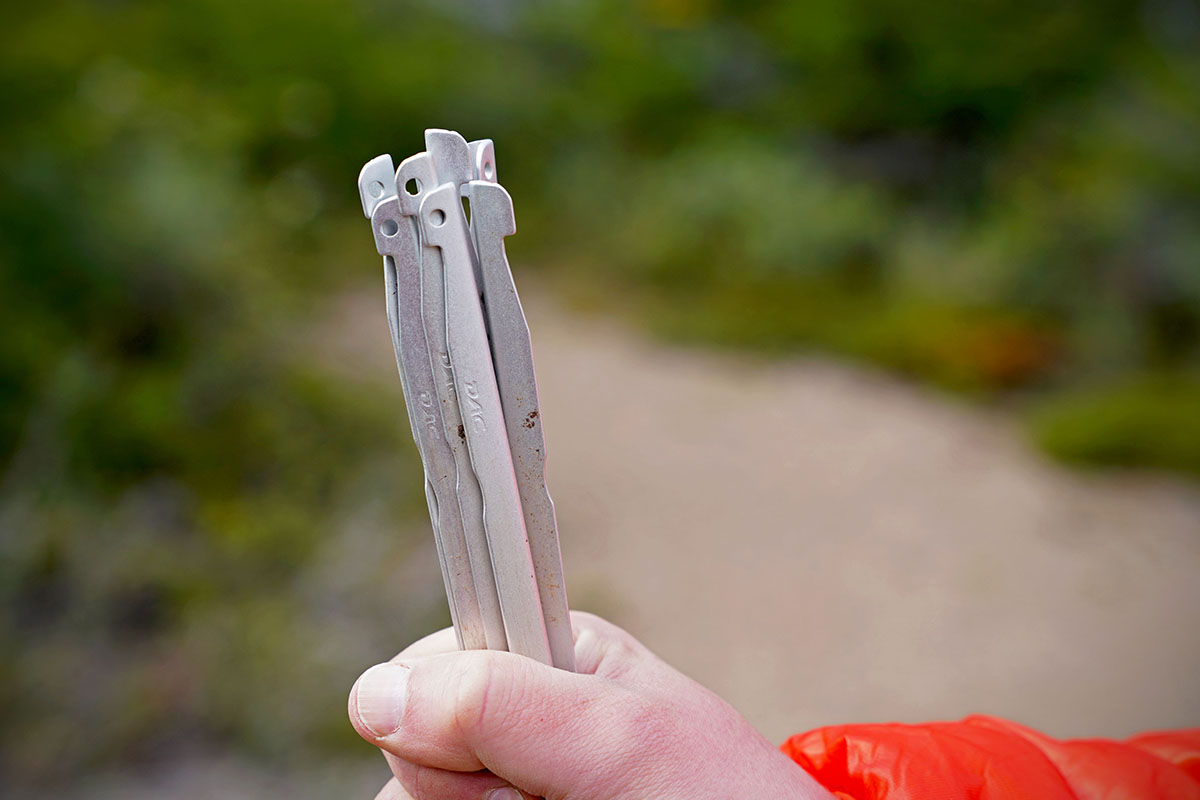

0 Response to "How To Set Up A Big Agnes Copper Spur Tent"
Post a Comment